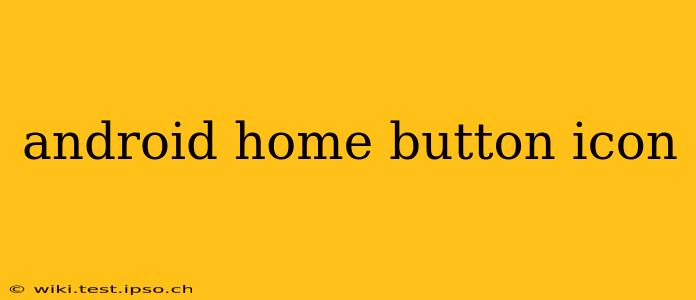The Android home button icon, that familiar house-shaped symbol, is more than just a pretty picture; it's a crucial element of the user interface, guiding users back to the home screen and providing a consistent experience across countless devices. This guide delves into the icon's design, evolution, and significance, answering many frequently asked questions about its functionality and meaning.
What is the purpose of the Android home button icon?
The Android home button icon serves as a quick and intuitive way to return to the home screen from any application or screen within the Android operating system. A single tap on this icon instantly closes all open apps (except system processes) and brings you to the main screen displaying your widgets, apps, and folders. Its consistent placement and instantly recognizable design makes it a vital navigation tool for all Android users.
What does the Android home button icon look like?
The Android home button icon is typically depicted as a stylized house or home symbol. While variations exist depending on the manufacturer's skin or specific Android version, the core design remains consistently recognizable. The icon is usually a simple graphic, often white or light-colored against a darker background, emphasizing its visual clarity and easy identification. The design prioritizes simplicity and quick recognition, ensuring users can effortlessly identify it regardless of the overall theme.
Has the Android home button icon changed over the years?
Yes, subtle variations have occurred over the years. The core design principle of a house-like shape has remained constant, ensuring brand recognition. However, Android versions and manufacturers have incorporated slight changes in color, shading, or level of detail. These modifications are usually minor, maintaining the overall familiar look and feel while adapting to evolving design language.
How do I access the home screen if my phone doesn't have a physical home button?
Many modern Android phones have abandoned physical home buttons in favor of on-screen navigation. In these cases, the home button icon is represented as a software button on the navigation bar at the bottom of the screen. Its functionality remains the same – a tap returns you to the home screen. Some manufacturers also offer gesture-based navigation, where a swipe up from the bottom of the screen can serve as the equivalent of pressing a home button.
What is the difference between the home button and the back button in Android?
This is a crucial distinction. The home button takes you to the home screen, closing all open applications. The back button navigates you back one step within the current application. For example, if you're deep within a menu in a specific app, the back button steps you back through the menus. The home button, on the other hand, completely exits the application and returns you to the home screen.
Can I customize the Android home button icon?
While you generally can't replace the core system home button icon with a completely different image, some launchers (third-party home screen replacements) offer customization options. These launchers might allow altering the icon’s appearance or its behavior, though the fundamental function will always remain the same. However, modifying core system icons is usually not recommended, as it can potentially destabilize the operating system.
Is there a hidden meaning behind the Android home button icon?
No secret meaning is publicly acknowledged behind the design. The simple, house-shaped icon was chosen for its intuitive and universally understood representation of "home" – a place of rest and return. The design prioritizes simplicity and clarity over complex symbolism.
This comprehensive guide clarifies the Android home button icon’s function, evolution, and significance, addressing common user queries and offering a deeper understanding of this fundamental element of the Android experience.
